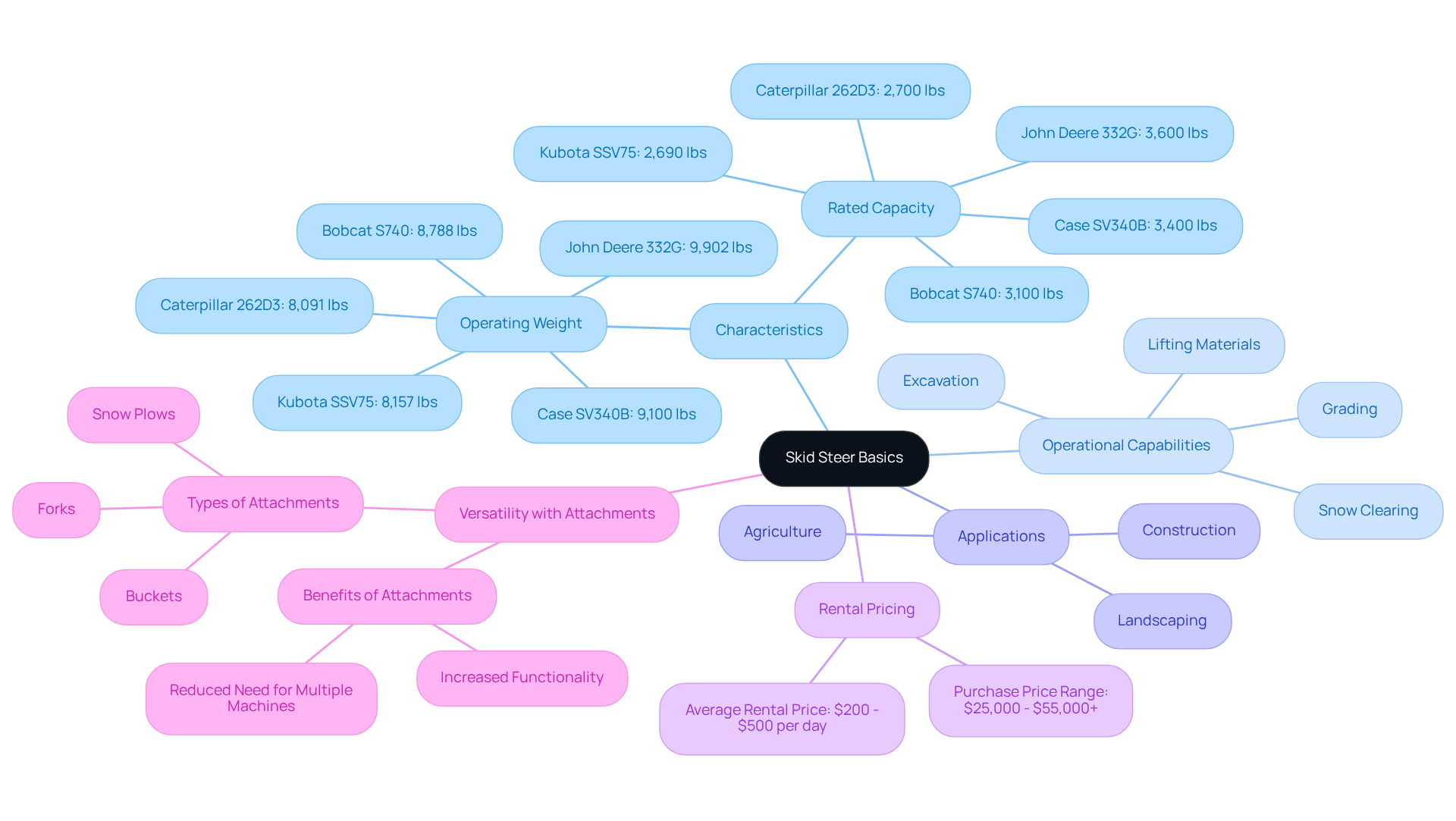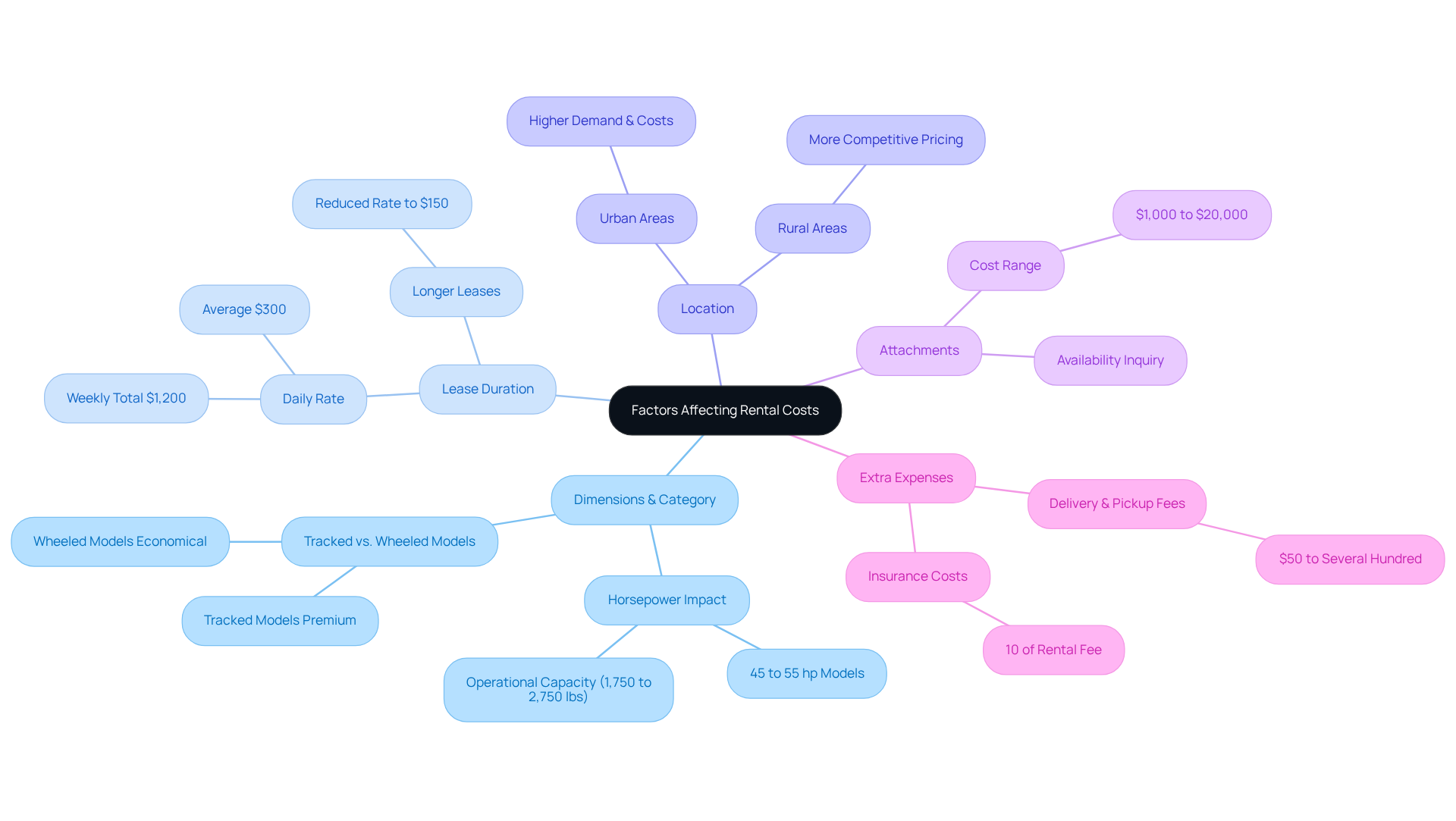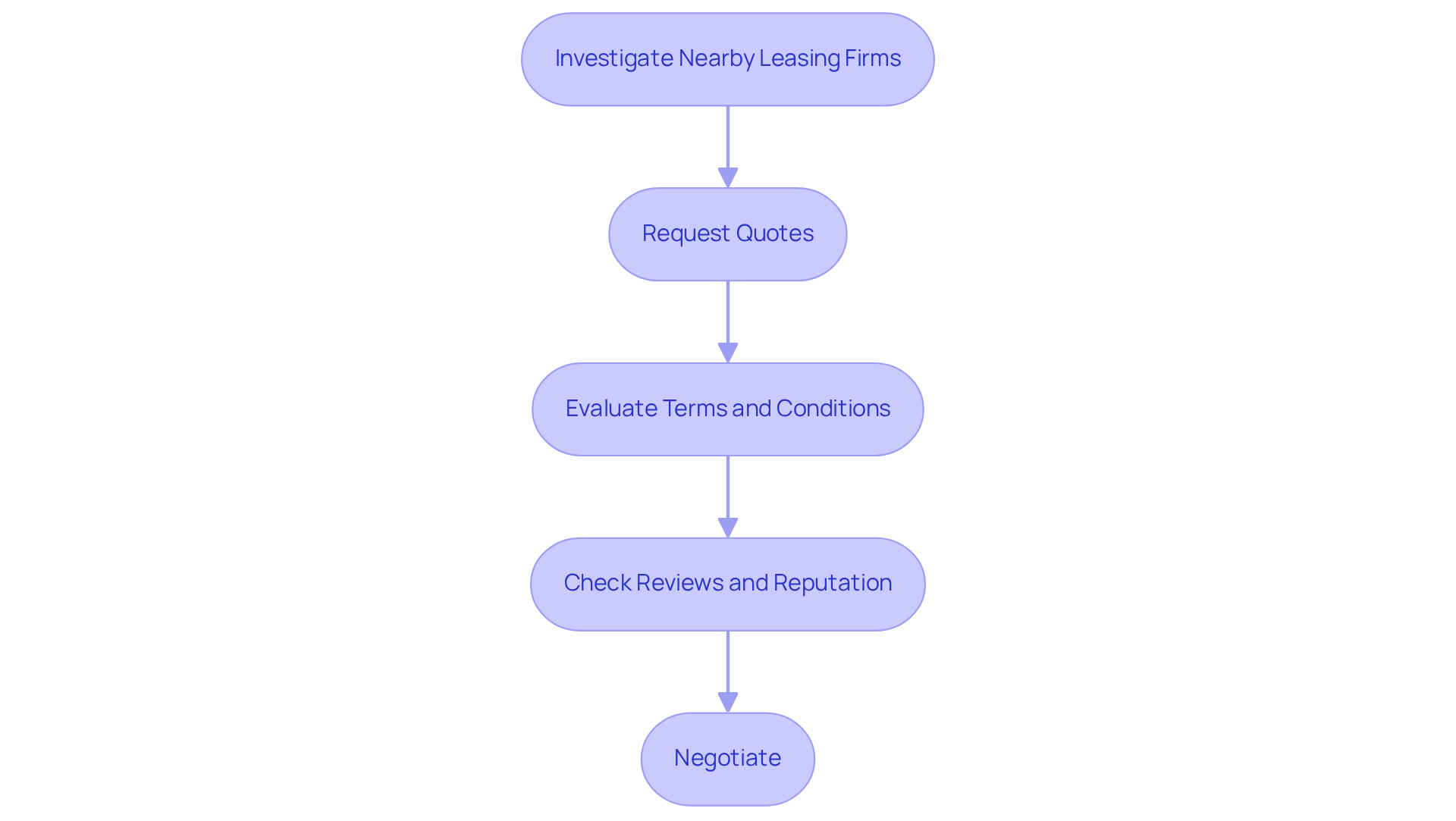Overview
Renting a skid steer typically incurs a cost ranging from $200 to $500 per day. This price is influenced by several factors, including:
- The machine's size
- Horsepower
- Lease duration
- Geographical location
- Any additional attachments required
Understanding these variables is crucial for making informed decisions in the rental process. Moreover, thoroughly reviewing rental agreements can help avoid unexpected expenses and ensure that the rental aligns with your project needs. By grasping these key elements, you can confidently navigate the equipment rental landscape and select the best options for your specific requirements.
Key Highlights:
- Skid loaders, or compact loaders, are versatile machines used for excavation, grading, and material handling, suitable for construction and landscaping.
- Tracked skid loaders typically weigh between 8,000 to 9,900 lbs and have operational capacities from 2,700 to 3,600 lbs.
- The average rental cost for skid steers ranges from $200 to $500 per day, depending on size and model, with extended leases potentially lowering daily rates.
- Key factors affecting rental costs include dimensions and horsepower of the loader, lease duration, geographical location, and additional attachments.
- Rentals may incur extra expenses such as delivery fees and insurance, which should be factored into the overall budget.
- When renting, it's important to compare quotes from multiple firms, understand lease terms, cheque company reputations, and negotiate terms if possible.
- Thoroughly review the rental agreement, including lease duration, cost breakdown, liability, maintenance responsibilities, and return conditions to avoid unexpected charges.
Introduction
Understanding the cost of renting a skid steer is essential for anyone involved in construction, landscaping, or agricultural projects. These versatile machines are increasingly popular due to their ability to maneuver in tight spaces and perform a variety of tasks. As the rental market evolves, it presents a range of pricing options tailored to different needs.
However, with numerous factors influencing rental costs—from machine specifications to geographical location—navigating this landscape effectively can be challenging. This article delves into the intricacies of skid steer rental pricing, offering insights that empower project managers to make informed decisions and optimize their equipment leasing strategies.
Understand Skid Steer Basics
A compact loader, commonly referred to as a skid-loader, stands as a versatile piece of construction machinery essential for a range of tasks, including excavating, leveling, and material handling. These machines are characterized by their distinctive steering mechanism, which allows them to pivot in tight spaces, making them particularly well-suited for landscaping, construction, and agricultural applications. Skid loaders come in various sizes and configurations, encompassing both wheeled and tracked models, each tailored to specific terrains and job requirements.
The fundamental characteristics of tracked vehicles include their operating weight, which typically ranges from approximately 8,000 to over 9,900 lbs, and their rated operational capacities, generally falling between 2,700 and 3,600 lbs. For example, the John Deere 332G boasts an operating weight of 9,902 lbs and a rated capacity of 3,600 lbs, while the Bobcat S740 weighs 8,788 lbs with a capacity of 3,100 lbs. These specifications underscore the machines' capability to handle substantial loads while maintaining excellent maneuverability.
Skid loaders excel in executing a variety of tasks, such as excavation, grading, lifting materials, and even snow clearing. Their compact design enables efficient operation in confined spaces, rendering them invaluable on urban and residential job sites. Furthermore, they can be outfitted with various attachments, which enhances their functionality and minimizes the need for multiple dedicated machines. As highlighted by Five Star Equipment, "We take pride in providing quality and performance by offering an extensive selection of compact machines for diverse uses—from construction to landscaping."
In 2025, average rental prices for compact machinery, including how much does a skid steer cost to rent, vary by size and model, typically ranging from $200 to $500 per day, depending on the specific features and capabilities required for the task. Understanding these fundamental characteristics and functions is crucial for selecting the appropriate equipment model for your project needs. Moreover, case studies have shown that utilizing compact loaders can significantly enhance efficiency on job sites, as they can perform multiple tasks with the right attachments, ultimately reducing operational costs.

Identify Factors Affecting Rental Costs
Understanding how much does a skid steer cost to rent is influenced by several key factors, which can enhance your equipment leasing strategy.
-
Dimensions and Category: The dimensions and horsepower of a compact loader are crucial in determining leasing costs. Larger models, particularly those with 45 to 55 horsepower, command higher rates due to their increased operational capacity, ranging from 1,750 to 2,750 lbs. Furthermore, the type of skid steer plays a vital role; tracked models often come at a premium compared to wheeled ones, as they offer superior versatility on uneven surfaces.
-
Lease Duration: The length of the leasing period is essential in assessing overall expenses. In 2024, if you're wondering how much does a skid steer cost to rent, the fundamental charge for leasing a loader typically varies from $200 to $500 daily, depending on the model and features. To understand how much does a skid steer cost to rent, one day typically costs around $300, while a week-long rental totals approximately $1,200, leading to an average daily rate of $240. However, extended leases can lower the average daily rate to about $150, making it essential to consider how much does a skid steer cost to rent in order to align your lease duration with your project timeline and avoid unnecessary costs.
-
Location: The geographical area of your project can significantly impact pricing. Urban regions often experience higher demand, resulting in elevated leasing rates, while rural areas may offer more competitive pricing. Understanding the local market dynamics can aid in effective budgeting.
-
Attachments: Specific attachments for skid steers, such as buckets or forks, may incur additional charges, ranging from $1,000 to $20,000 based on the required machinery. It is advisable to inquire about the availability and pricing of these attachments when arranging your rental.
-
Extra Expenses: Consider potential extra expenses, including delivery and pickup fees, which can vary from $50 to several hundred dollars depending on distance. Insurance costs for leasing a compact loader typically increase by about 10% of the rental fee. By factoring in these elements, construction project managers can make informed decisions that enhance their equipment leasing strategy and effectively manage costs.

Compare Rental Options and Pricing
When evaluating rental options for skid steers, it is crucial to consider how much does a skid steer cost to rent to ensure a successful experience.
-
Investigate Nearby Leasing Firms: Begin your search by identifying leasing companies in your vicinity, such as EZ Equipment Leasing, known for its extensive selection of compact vehicles and competitive rates. This foundational step sets the stage for a fruitful rental process.
-
Request Quotes: Reach out to multiple leasing firms to gather estimates for the specific equipment model required. Be explicit about the lease duration and any necessary attachments to obtain precise pricing. Typically, when considering how much does a skid steer cost to rent, prices range from $200 to $500 per day; this information will assist you in gauging the market effectively.
-
Evaluate Terms and Conditions: Carefully examine the leasing agreements for any hidden fees, such as delivery charges or insurance costs, which could significantly impact your total leasing expenditure. Understanding these terms is vital to avoid unexpected expenses and ensure a transparent transaction.
-
Check Reviews and Reputation: Delve into customer feedback and ratings for each provider. Companies with a solid reputation for customer support and equipment quality often justify a slightly higher leasing rate due to their reliability. Remember, exceptional customer service and clear communication are critical factors in selecting an equipment provider.
-
Negotiate: Do not hesitate to discuss leasing conditions or request discounts, particularly for long-term agreements. Many leasing firms are open to negotiations to secure your business, ultimately enhancing your overall value. As one expert noted, "Obtain estimates from various equipment leasing companies to provide you with a clearer understanding of which providers are most suitable for your budget.

Review Rental Agreements and Terms
Before finalizing your skid steer rental, it is crucial to thoroughly review the rental agreement and its terms.
Lease Duration: Confirm the start and end dates of your lease period. It is essential to understand the policy for extending the lease if needed, ensuring that your project timelines align with the rental terms.
Cost Breakdown: Ensure that the agreement clearly outlines how much does a skid steer cost to rent, including any additional fees for delivery, insurance, or attachments. Understanding how much does a skid steer cost to rent will help you budget effectively and avoid unexpected expenses.
Liability and Insurance: Understand your liability in the event of damage to the equipment. Some leasing firms may require you to purchase insurance or provide proof of coverage, which is vital for protecting your interests.
Maintenance Responsibilities: Clarify who is responsible for upkeep during the leasing period. Typically, the rental company handles maintenance, but you may be responsible for minor upkeep, ensuring the equipment remains in optimal condition.
Return Conditions: Review the conditions for returning the skid steer. It is important to understand any cleaning or repair requirements to avoid additional charges upon return, ensuring a smooth conclusion to your rental experience.

Conclusion
Understanding the costs associated with renting a skid steer is essential for anyone involved in construction, landscaping, or agricultural projects. These compact loaders offer not only versatility and efficiency but also come with a range of pricing influenced by factors such as model size, rental duration, location, and necessary attachments. By grasping these elements, you can make informed decisions that align with your project needs and budget constraints.
Key insights from this article underscore the importance of:
- Comparing rental options
- Investigating local leasing firms
- Thoroughly reviewing rental agreements
The average rental prices for skid steers can vary widely, typically ranging from $200 to $500 per day, depending on the machine's specifications and the rental terms. Furthermore, understanding the implications of lease duration and potential extra costs, such as delivery fees and insurance, can significantly impact your overall expenses.
Ultimately, making the right choice in skid steer rentals can lead to increased efficiency on job sites and better management of operational costs. It is advisable to conduct thorough research, solicit multiple quotes, and negotiate terms to secure the best value. By taking these steps, you can ensure a smooth rental experience that supports the successful completion of any project.
Frequently Asked Questions
What is a skid steer and what are its primary uses?
A skid steer, also known as a compact loader, is a versatile piece of construction machinery used for tasks such as excavating, leveling, and material handling. It is particularly suited for landscaping, construction, and agricultural applications.
What are the key characteristics of skid loaders?
Skid loaders are characterized by their unique steering mechanism that allows them to pivot in tight spaces. They come in various sizes and configurations, including wheeled and tracked models, which are tailored to specific terrains and job requirements.
What is the operating weight and rated capacity of tracked skid loaders?
Tracked skid loaders typically have an operating weight ranging from approximately 8,000 to over 9,900 lbs, with rated operational capacities generally falling between 2,700 and 3,600 lbs.
Can you provide examples of specific skid loader models and their specifications?
The John Deere 332G has an operating weight of 9,902 lbs and a rated capacity of 3,600 lbs, while the Bobcat S740 weighs 8,788 lbs with a capacity of 3,100 lbs.
What tasks can skid loaders perform?
Skid loaders excel in tasks such as excavation, grading, lifting materials, and snow clearing. Their compact design allows for efficient operation in confined spaces.
How can skid loaders enhance job site efficiency?
Skid loaders can be outfitted with various attachments, allowing them to perform multiple tasks and reducing the need for several dedicated machines, which can significantly enhance efficiency and reduce operational costs.
What are the average rental prices for skid steers in 2025?
In 2025, average rental prices for skid steers typically range from $200 to $500 per day, depending on the size, model, and specific features required for the task.




